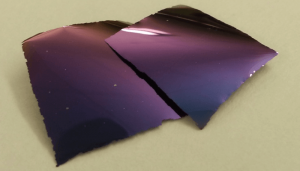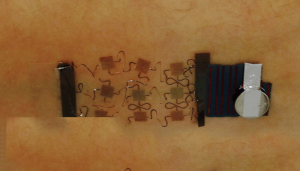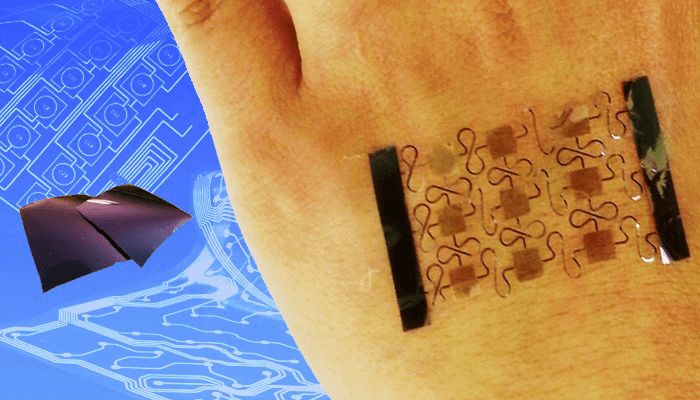International Institute of Information Technology Hyderabad (IIITH)’s semester-long course on Flexible Electronics is a one-of-its-kind offering in the country today.
Ever since the step-counting fad exploded over the last decade, the consequent interest in fitness tracking devices and other wearables has boomed too. These devices would not have been accessible to the general populace if they were not portable, lightweight, less expensive and flexible. Flexibility in electronics is the current hottest tech trend with universities, and industries around the world researching this technology. Since the idea is to make conventional electronics thin, bendable and stretchable, material science forms the very core of this emerging science. Conventional glass substrates and semiconductors have given way to flexible substrates such as plastic, paper, textiles and metal foils.
While visibility of this tech is most prominent in displays such as smartphones and computers, the potential applications of this technology span across various manufacturing sectors. They include and are not limited to energy (think bendable photovoltaic cells that can wrap around any roof shape), health (user controlled diagnostics, packaging of medicines), defence and security (wearables in soldier’s gear), environment (disposable sensors for air and water quality monitoring), communication and transport (ticketing and listing of rail passengers and parcels, airport baggage handling), education (labelling of books in libraries, answer scripts in exams) and so on.
The Course
IIITH has been a pioneer in offering the first full fledged 4-credit semester course in India on Flexible Electronics as a level 2 elective to Electronics and Communications Engineering students. This means that students studying BTech 3rd and 4th year, 5th year Dual Degree, Masters and PhD are eligible for it. Taught by Dr. Aftab Hussain whose core area of expertise lies in flex circuits, the course requires no pre-requisites apart from an exposure to 10+2 level of Physics and Chemistry from prospective students.
What Is It About?
Since the world we inhabit is one powered by computer circuits that are typically silicon-based, the course kicks off with an overview of building a silicon processor. “What I generally do is to give students a block diagram of any simple electronic system, saying any electronic system would have a processor, a memory, a display, maybe a sensor, maybe a battery, antenna, etc. Then we go through how we can flex each of them, i.e, how we can create a flexible version of each of these things. If we want to make the entire device flexible, we would first want each of these components flexible. For instance, you can’t have everything else flexible but memory rigid..it won’t work. Everything has to be flexible,” says Dr. Hussain. Continuing with the example of the memory, Prof. Hussain says that one needs to know how a memory works before tweaking the material system in order to make it overcome the rigidity of conventional silicon technology. In this way, students eventually learn how to make all components that go into an electronic system flexible – such as a flexible memory, flexible antennas, flexible batteries, flexible solar cells and so on.

Advanced Electronics
This is a course that involves an advanced level of electronics. And since materials science lies at the very heart of this technology, students stand to gain immense exposure and knowledge of both circuitry as well as materials. While learning how an OLED works, they also learn about organic LEDs, the manner in which they are made, the organic processing that takes place, how polymers conduct electricity to become semi-conducting or conducting polymers and so on. “Students learn a lot of base theories and technologies. They’ll all have heard of Amoled displays because their phones are made out of them. Hence when I teach them how it works, it’s very interesting for them,” says Dr. Hussain, adding, “Flexibility is one part of it but there’s a lot of advanced electronics that is taught to them. Even if they don’t remember how to make things flexible, I’m sure they’ll remember how an OLED works, a memory, light emission or a lithium ion battery works.”

Creative Projects
Towards the end of the course, students are typically given an option of either submitting a term paper which is basically a review of a specific flexible electronics technology or dabbling in a project and writing a report on it. “I tell them upfront that I will be more generous with grading if they come up with a project, because it’s harder to make things work on hardware,” says the professor. For him, the most memorable project he was asked to review last year was a flexible speaker that worked perfectly. “They (students) made it play a song and it was flexible.” This year, before the Covid-19 pandemic disrupted classroom schedules, the professor was more excited about project work thanks to the setting up of the Maker’s Lab on campus. “We now have laser cutters, and 3D printers in the Maker’s lab, so we could have used them and made something more creative. Maybe next year when we have this course, we could use them. I also have flexible PCBs with me, so we can do a lot of things in-house,” says Dr. Hussain.
The Future
The field of flexible electronics is a promising one that goes beyond folding displays, inexpensive solar cells, antennas and sensors. An emerging frontier is towards implantables in medicine and health technology. “But in order to make anything that can be implanted into the human body, to make it behave like a normal biological tissue, we need to have some kind of flexibility to it. I always begin my course with an introduction about how Biology is and how we have tried to emulate it. For a better biological emulation, we would probably need flexible materials. To make devices that stretch as much as our skin stretches. That’s why so much research is going on in this field now,” says Dr. Hussain. The field itself is so new that research is rare and academic courses in it are rarer still. While there are a few research groups in the country working in this area including an entire center in IIT Kanpur (Center for Large Area Flexible Electronics), IIITH can count itself among the select few institutes worldwide to have a comprehensive course offering.



Next post